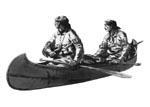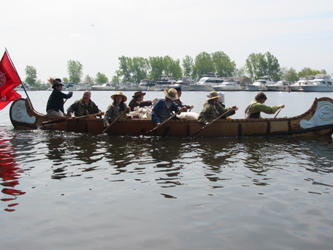

The
Bark Canoe Store
2317 West Fairview Avenue
Spokane, WA 99205
(509)327-7902
(509)327-7989
barkcanoe@earthlink.net
www.barkcanoe.com
John Lindman
proprietor/builder
copyright (c) 2005
All Rights Reserved
IN THIS ISSUE
1. News - New Line of Fiberglass Replicas
2. Building Tip -
a. Super size me - Measurements for a 26ft Fur Trade "North Canoe"
b. More on Miniatures by Ted Behne
News - 18' Ottawa Fiberglass Replica Canoe

Boy this has been a dream in the making for a long time and finally the first in-house
replicas are coming off the line. We are still tweaking things but are pleased with our results.
This first design is 18' long with a beam of 36" and a depth of 13". As you can see by the
photos it has a sharp entry and shallow arched hull. The idea was for a fast paddling, yet stable
canoe that can haul two people with gear comfortably - a trekking canoe for rivers, and rough lakes.
It is an Ottawa model - typical of those found among the affiliated Ojibwe bands from Wisconsin east, all the way to Quebec.
The one shown here has no ribs but the other shots show them with ribs. This is an extra feature that can be added. With ribs it weighs 65
pounds, without the weight comes in at 45 pounds.
They are trimmed with white ash gunwales, black ash thwarts, and synthetic pitch and lashings.
An extra lashing kit and instructions can be purchased if you would like to lash the entire canoe.
Between making birchbark canoes I am setting up the production facility. It is hoped for next fall
to add two other designs, the fur trade and the Abenaki - both about 18ft long. We intend
to create a final model in the spring, a 16ft Ojibwe Longnose. I will keep you posted with
photos as things progress.
Let me know if you have any questions. A brochure will be forthcoming.
Building Tip a. - Super size me!
Measurements for a 26ft fur trade "North Canoe"

In case you have plans to build a 26' fur trade canoe here are some measurements that perhaps could be of some assistance. I checked in Adney's book "The Bark Canoes and Skin Boats of North America" as well as Tim Kent's book "Birchbark Canoes of the Fur Trade Part II" for measurements of former and existing fur trade canoes. There were none that were exactly 26' so I had to use a few canoes to get an idea of what would be appropriate. Both books were very helpful especially Tim's book.
Let me tell you, when I did a mock up of the prow and it was inside the house it looked huge! I thought it must be too big. Ah, but once outside and positioned with gunwales and the building frame it looked right. The canoe is done and the lines turned out pretty much how I had intended. I just got back recently from Winnipeg - I hauled it out there along with 3 16ft bark canoes. Hell of a deal when I hit North Dakota - strong winds. The semis would just blow my poor canoes around. This canoe departed Montreal in late May for Thunder Bay. There will be more photos of this "Big Bad Boy" in up coming newsletters.
While Tim's book provided very valuable measurements as did Adney's no book exists to my knowledge that provides the measurements needed to arrive at the final measurements. To me that would be very helpful. Therefore I am passing this on to you.
Here are the measurements:
Frame
Length - 23'
Width - 36"
Materials - Douglas Fir Gunwales, Black Ash Thwarts, White Cedar Ribs and Sheathing White Spruce Root.
Finished Canoe
Length - 26'
Beam - 56"
Depth at Center - 20.5"
Prow Height - 40"
Height Sticks
Center Thwart - 17"
1st Intermediate Thwart - 17"
2nd Intermediate Thwart - 18"
End Thwart - 18.5"
Note: These were positioned vertical from the building frame to beneath the temporary thwarts that were the exact same height as the lower edge of the inside gunwale.
Gunwales
Inside - 24' 4" long x 1" wide x 1.25" deep
Outside - 25' long x .5" wide x 1.25 deep
Cap - ... long x 1.5" wide x .5 deep
Thwarts
Center Thwart - 53" long
1st Intermediate Thwart - 46" long
2nd Intermediate Thwart - 29.5" long
End Thwart - 12.5" long
Distance between thwarts
Center to 1st Int - 9 lashings
1st Int to 2nd Int - 9 lashings
2nd Int to End - 8 lashings
End to Gunwale Tip - 8 lashings
Bark
Main hull sheet is 42" wide by 18' long;
end hull sheets are 36" wide by 5' long each.
Building Tip - More on Miniatures by Ted Behne
Splitting Cedar
Previous articles outlined the process for selecting a canoe to model, reducing its dimensions to one-quarter scale, making a "blueprint" of the canoe, constructing a reusable building platform, making a gunwale frame, making thwarts and installing them. This article will focus on splitting cedar, an obscure but important skill that underlies many of the steps in making a birchbark canoe.
To review previous articles, go to
The Bark Canoe Store - "Tips"
and sort through past issues of "The Bark Canoe Aficionado."
The wood is Northern White Cedar (Thuja Occidentalis) and it's pretty amazing stuff.
It is light, easily carved, bends well and is naturally rot and insect resistant for decades
with no weather protection. For canoe building, only the creamy-white wood in the middle of
the tree is used. The darker sapwood, growing nearest the bark, is too weak and does not bend
well. The heartwood at the center of the tree is prone to decay. Both the sapwood and the
heartwood should be discarded.
One of cedar's major assets as a canoe-building wood is its tendency to split smoothly along
lines of grain. Indeed, in the hands of someone who is skilled at splitting cedar, it can be
difficult to distinguish split wood from a similar piece that has been planed and sanded. But
more importantly, split cedar is stronger and bends more reliably than sawn cedar. That's
because sawing cuts through the lines of grain and significantly weakens any component made
with the wood. Many old museum canoes are so well built that they look as though they were
made with power tools. Much of that smooth finished look comes from the builder's skill with
a crooked knife, but creating the rough blanks to make gunwales, ribs, sheathing and headboards
comes from the builder's skill with splitting.
So what's the secret? How does a novice learn to split cedar like a pro? The same way you
get to Carnegie Hall: practice, practice and more practice. Theoretically it makes no
difference whether the cedar is wet or dry. It should split equally well, if it's fresh.
But in practice I have found that wet cedar splits more reliably and more easily than dry
cedar. Cedar splitting is a particularly valuable skill for making sheathing blanks. Good
quality cedar can literally be split down to a single growth layer - only a few thousands of
an inch thick - so thin that it looks and feels like paper.
Start by soaking the cedar overnight. Then mark a line at one end of the rough blank to begin
the split. Start the split with any sharp blade, and then "wiggle" the split open enough to
allow fingertips to take over the work. Ideally, the split should be made in the exact center
of the blank. The centerline approach equalizes the stresses on both halves of the split and
requires only that equal pressure be applied to both sides. But if a split begins to wander
to one side or another it can be moved right or left of center simply by applying a heavier
"pull" on the wood in the direction you want the split to go. To get sufficient "pull" to
move the split line one way or another you may have to jam the cedar blank between two table
legs (or your own legs for that matter) to get sufficient leverage. This "pull" phenomenon
can also be used to maintain an off center split from the beginning, such as when removing a
sapwood strip from a larger chunk of wood.
Try both methods until you master them. You will ruin a few cedar blanks, but the skills you
will acquire from the practice will serve you well for many future projects. Next, turn your
attention to making ribs, the essential skeletal structure of the canoe. That process will be
described in next month's newsletter.
If you have questions about any of the above, just send an email to
tedbehne@comcast.net.
You can view Ted's work here.
To remove yourself from this list, simply reply to this email with the word "REMOVE" in the subject.
------------------------------------------------------------------------------------------